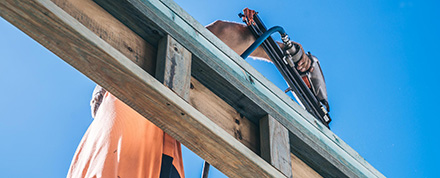A new body, the Timber Framing Collective, has been created with responsibility for the marketing of timber framing in Australia. It sees previously fierce competitors (local producers and importers, amongst others), join forces for the greater good of the industry to promote, establish and consolidate ‘Timber Framing The Ultimate Renewable’ as the leading building materials brand in Australia for residential construction. Source: Timberbiz
Australia faces a major sovereign capability gap in the production of timber house frames by 2035, according to a landmark new report by Master Builders Australia and the Australian Forest Products Association.
The collective receives financial support from Australian sawmills, timber importers, industry associations and peak bodies, building products and treatment suppliers. These supporters currently include Australian Forest Products Association (AFPA), AKD, Boral Timber, Hyne Timber, OneFortyOne, Timberlink Australia, Wespine, Australian Timber Importers Federation (ATIF), Forest & Wood Products Australia (FWPA), Frame & Truss Manufacturers Association (FTMA), Koppers, Lonza, MiTek, Multinail, Pryda, Responsible Wood, Stora Enso, TABMA, Timber Queensland and Vida.
“While competitor building materials may have deeper pockets than ours in terms of advertising media spend, what we have is a supply chain that is unrivalled in size,” Timber Framing Collective spokesperson Marita Pierce-Indugula said.
“Within that supply chain are people who are passionate about timber and are chomping at the bit to work with us to promote the many benefits of timber framing over other building materials.
“Timber has no equal when it comes to its environmental credentials,” he said.
While other building materials add to carbon emissions, the timber framing industry was working with a natural sustainable product that stores carbon. Wood also has the lowest embodied energy of all common building materials.
“With a typical Australian home absorbing more than seven tonnes of carbon dioxide (CO2) from the air and storing almost 3 tonnes of carbon, it really makes timber framing the superior choice and the ultimate renewable,” Marita Pierce-Indugula said.
“Right now, demand is outstripping supply, but this will level out in time so it’s important that builders, consumers, decision makers and influencers understand the many benefits of timber framing through the efforts of the new Timber Framing Collective.
“We’re asking builders and consumers to continue being patient as supply catches up with unprecedented demand, in the knowledge that they are making a fantastic environmental decision to build with timber framing.”
A series of campaigns will be released to market over the coming months.






